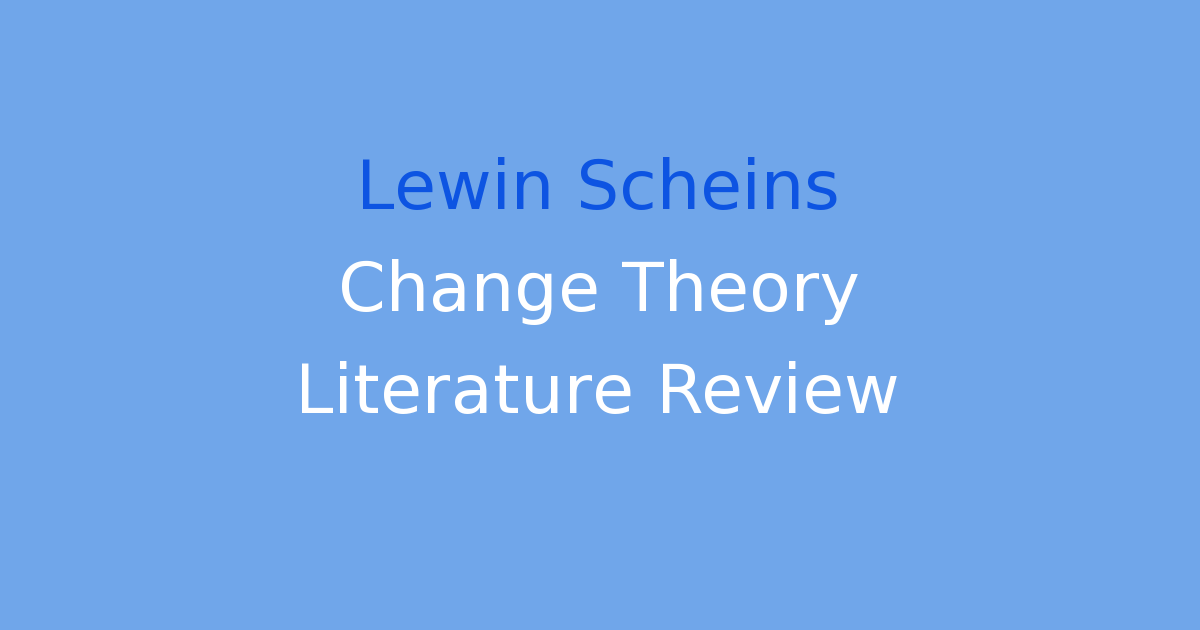Literature review on Lewin and Schein’s change theory.
Introduction
In the field of organizational change management, the theories developed by Kurt Lewin and Edgar Schein are two of the most influential and widely studied. Both theories provide valuable insights into the process of change in organizations and offer guidance on how to effectively implement and manage change initiatives. This literature review will examine the key concepts of Lewin’s Change Theory and Schein’s Change Theory, compare and contrast the two theories, and analyze their relevance in the context of modern organizational change management practices.
Problem Statement
Organizational change is a complex and challenging process that requires careful planning, communication, and implementation. Many organizations struggle to effectively manage change initiatives, leading to resistance, confusion, and ultimately, failure. Understanding the underlying theories of change can help organizations navigate these challenges and increase the likelihood of successful change implementation. By analyzing and comparing Lewin’s Change Theory and Schein’s Change Theory, this literature review aims to provide insights into best practices for managing organizational change.
Existing System
Lewin’s Change Theory, developed by psychologist Kurt Lewin in the 1940s, is based on the concept of unfreezing, changing, and refreezing. According to Lewin, change begins by unfreezing the existing state of the organization, creating a sense of dissatisfaction with the current state, and preparing employees for change. The change phase involves implementing new processes, systems, or structures, and the refreezing phase involves stabilizing the change and integrating it into the organization’s culture.
Schein’s Change Theory, developed by organizational psychologist Edgar Schein in the 1990s, focuses on the role of organizational culture in driving change. Schein argues that successful change requires a deep understanding of the organization’s culture, values, and beliefs. Real change, according to Schein, occurs when core beliefs and assumptions are challenged and transformed.
Disadvantages
While both Lewin’s Change Theory and Schein’s Change Theory have been widely influential in the field of organizational change management, they are not without their limitations. Lewin’s three-step model of change has been criticized for its oversimplification of the change process and its linear, top-down approach. Some critics argue that the unfreezing, changing, and refreezing model fails to account for the complexity of modern organizations and the role of individual and group dynamics in driving change.
Schein’s focus on organizational culture has also been criticized for its reliance on subjective interpretations of culture and its limited practical applicability. Critics argue that Schein’s emphasis on culture may neglect other important factors influencing change, such as leadership, communication, and stakeholder engagement.
Proposed System
To address the limitations of existing change management theories, a hybrid approach that integrates elements of Lewin’s Change Theory and Schein’s Change Theory may be beneficial. By combining Lewin’s focus on process and Schein’s focus on culture, organizations can develop a more comprehensive and nuanced understanding of change dynamics.
One proposed model for change management is the Lewin-Schein Integrated Change Model, which incorporates the three-step process of unfreezing, changing, and refreezing with an emphasis on cultural transformation. This model recognizes the importance of both internal and external factors in driving change and provides a framework for aligning organizational values and beliefs with strategic objectives.
Advantages
The Lewin-Schein Integrated Change Model offers several advantages over traditional change management approaches. By combining the structured approach of Lewin’s Change Theory with the cultural insights of Schein’s Change Theory, organizations can develop a more holistic understanding of the change process and better align their change strategies with organizational goals. Additionally, the emphasis on cultural transformation in the integrated model can help organizations overcome resistance to change and foster a climate of innovation and collaboration.
Features
Key features of the Lewin-Schein Integrated Change Model include:
– An emphasis on cultural transformation
– A focus on aligning organizational values and beliefs with strategic objectives
– A recognition of the importance of both internal and external factors in driving change
– A structured approach that guides organizations through the unfreezing, changing, and refreezing phases of change
– A focus on leadership, communication, and stakeholder engagement
Conclusion
In conclusion, the theories developed by Kurt Lewin and Edgar Schein provide valuable insights into the process of organizational change. While both theories have their limitations, by integrating elements of Lewin’s Change Theory and Schein’s Change Theory, organizations can develop a more comprehensive and effective approach to managing change. The Lewin-Schein Integrated Change Model offers a structured framework for aligning organizational values with strategic objectives, overcoming resistance to change, and fostering a culture of innovation and collaboration. By adopting this hybrid approach, organizations can increase the likelihood of successful change implementation and achieve lasting organizational transformation.

